Eric Anthony (E.A) Sykes was one of the true pioneers of what we now term “Combatives”, that is to say “Close Quarter Combat whether Armed or Unarmed”.
As with so many of the Instructors of World War Two not much is known about him. The life and times of Sykes seems to begin and end in mystery.
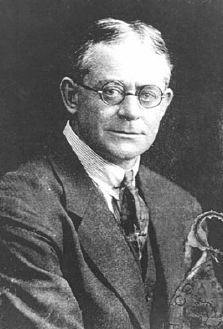
"Eric Anthony Sykes - The Forgotten Hero of Combatives" by Phil Matthews. Copyright 2005 - thebristolbloke
Introduction
Eric Anthony (E.A) Sykes was one of the true pioneers of what we now term “Combatives”, that is to say “Close Quarter Combat whether Armed or Unarmed”.
As with so many of the Instructors of World War Two not much is known about him, at least not much that is admitted to publicly. The Passport Photograph featured above is the only one publicly available (thanks to Col. Rex Applegate), some more are rumoured to exist in private collections.
The life and times of Sykes seems to begin and end in mystery. All that anyone seems to know (or is written about in books) is that he was Fairbairn’s Instructor partner – one half designer of the famed F-S Fighting knife and an Instructor to Special Forces and Secret Agents during World War Two.
As a researcher into the Combative Arts and their Instructors I firmly believe that none of the Instructors suddenly appeared out of “nowhere” to serve the Allies in their time of need. Their service was given freely, of much use and many of the trainee’s who undertook Instruction by those much needed persons stated that that owed their very lives to their teachings.
With this in mind whenever I research an Instructor I ask myself the questions: who was this man, where did he come from, why have we allowed his memory to be so dishonoured that we know so little about them to this day? As with any of my writings this is only “a work in progress”, the facts I write are as I ascertain them – I can back them up but am always willing to be proved wrong.
I cannot let the memory and life’s work of Eric Anthony Sykes and his teachings to fade into the obscurity it has met thus far, to not allow his legacy the respect and debt of thanks it deserves would be criminal.
So I write this.
Sykes – The Early Years
Even the birth of Eric Anthony Sykes has on itself an air of mystery as he was actually born with the name 'Eric Anthony Schwabe' on the 5th of February, 1883. This was in a place called Barton on Irwill in Lancashire; there he was the eldest son of Lawrence and Octavia Schwabe.
Although his own father of was of German origin Lawrence Schwabe was a successful businessman in the United Kingdom (and abroad) in the cotton trade of the time.
His mother Octavia Ermen was herself from a family of cotton merchants who were even at one-stage business partners to the father of Friedrick Engels (the co-Author of the book “The Communist Manifesto” with Karl Marx).
Financially solvent they were blessed with another son two years later who was named Randolph. Though he was to make out his own very different future and destiny through his own talents he was always very close to his brother Eric.
Little is known of the schooling of Sykes but around 1907 it is believed that he made his way abroad to live and work in the city of Shanghai in China, this was the so called “Great Age” of British Empire and colonialism was at it’s peak.
The Schwabe’s and other parts of the extended family had already been conducting business for some time in the Far East (Manila, Hong Kong, Singapore and Shanghai) but it is not certain that Sykes had gone there intending to be a part of the family enterprise.
In fact, given that there was an extensive family business influence in that large area of British Colonialism for such a long period (since around 1835) it is somewhat surprising that Sykes chose not to join his family businesses there. Little wonder then that some researchers have made a connection to his later work being a cover for working with Britain’s Secret Intelligence Services.
On this all I can say is that the Intelligence Services of Britain have always been Institutions with closed doors and closed records. I have no materials or contacts within these places to substantiate other’s research.
I can only say with honesty that I have conducted my own research and come to the same conclusions as some, but perhaps for different reasons...
Likewise I know (or can substantiate) nothing of any service (Military or otherwise) that he may have undertaken during the First World War, that is the stuff of other researchers – I have no proof one way or the other.
What is known is that on the 31st of May, 1917 he changed his surname to an anglicised version of the Germanic original and became known as “Sykes” whilst in Shanghai.
Sykes – The Shanghai Years
A change in name though was in itself was not an uncommon thing for the period.
In fact the British Royalty with its family name of “Saxe-Coburg” changed their family surname to that of “Windsor” around that same timeframe. This was mostly due to the problem/issue of anti-German sentiment that was prevailing then, due mostly because of the costly (and ongoing) war with Germany under its then leader Kaiser Wilhelm.
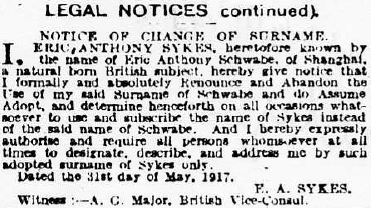
At the time the city of Shanghai still had a British Settlement and this was where Sykes lived and worked, it was popular (and sometimes sensible for reasons of self preservation) for "Patriotic Englishmen" with Germanic connections to change their names in this way across the then British Empire.
Sykes is on record as having worked for differing companies at differing lines of work whilst in Shanghai. What is generally accepted is that his friendship with W.E Fairbairn began as a direct result of his being the Shanghai representative for the American Firearms and Ammunitions companies Colt and Remington. It was during this time that he and Fairbairn introduced the practice of “Bullet Marking” on SMP ammunition.
Here the history begins to blur again, Sykes ostensibly made his daily living by working in private companies but it is fairly agreed upon that he joined the Shanghai Municipal Police Reserve as a Special Constable in 1926. I know very little of the intervening years until the war apart from two facts.
He was still much involved with Firearms and training (what would later be termed “Defensive Tactics” and “Use of Force on Force”).
He married an American divorcee by the name of Catherine Powell, a lady who originated from the city of Reno in the US state of Nevada.
In these latter years in Shanghai Sykes worked closely with Fairbairn and the two of them became close friends. They collaborated together on a book on Pistol Shooting which is still published by Paladin Press today – entitled “Shooting To Live”.
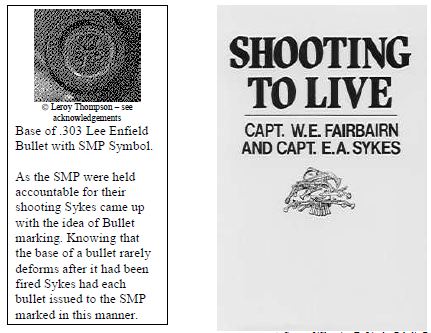
This book is an amazing resource not only on what would later be termed “Point Shooting” by the Firearms community, but also on the reactions of a human being under stress. Gross motor movements, the reaction under stress whether shooting or shot at, the results from practical research from the field. It was arguably the first of it’s time to address that all too often forgotten ingredient in any type of personal confrontation - the human element.
All this and it was also the only publicly published work that I know Sykes to have ever put his name to - add it to your library not only as a historical resource but because you’ll learn from it!
As co-author Sykes was listed as being “Late Officer In Charge Snipers Unit, Shanghai Municipal Police”, the book however was published in 1942 – well after Sykes and Fairbairn had left Asia and World War Two had begun.
Shanghai had been described as ‘the most violent city of the world’ and both Sykes and Fairbairn each had more than their share of violent encounters in the line of duty, these were the some of the experiences they wrote about in Shooting To Live.
Towards the latter end of the 1930’s it had become plain to most Colonial’s that Europe was on a course for war with Germany again. The expansion of the Japanese Empire into Asia (through Manchuria), then leading South threatened not only the Southern Chinese States but also Shanghai itself.
Bombings and machine gun strafing from Japanese Military Aircraft into the largely civilian population of Shanghai were a daily occurrences. Massive influxes of refugee’s from outlying area’s coupled with continual bloody raids by Japanese soldiers; these only intensified the existing problems in a city which was already Internationally renowned noted for it’s high crime rate.
Sykes and Fairbairn of the Shanghai Municipal Police were on continuous call out to deal with one violent event after another, the situation which seemed could get no worse was deepened by the official declaration of war in Europe.
The military alliance of Nazi Germany and Japan meant that many of the Europeans who weren’t called up to serve in the Allied Armed Forces had to look out for themselves and make their own plans.
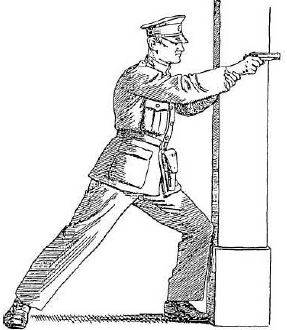
Sykes – The Early War Years
Both Sykes and Fairbairn retired from the SMP and arrived in Britain in the Spring of 1940, little knowing what was in store for them. Soon after arrival however they were both commissioned as Captain’s by the War Office after having been approached by a small and relatively obscure branch of the Secret Intelligence Service known as ‘Section D’.
‘Section D’ had been founded in March 1938 and was headed by a colourful Major of the Royal Engineers by the name of Lawrence Grand, history has it that he never appeared in public without a “perfectly furled umbrella and a red carnation”. Quite surprisingly he was in charged to lead his department to:
“Investigate every possibility of attacking potential enemies by means other than the Operations of Military forces”
This meant it’s brief was Irregular Warfare, Sabotage and Subversion, in later years the moniker of ‘Section D’ would be remembered as “D - For Destruction”.
Before the breakout of the war Section D had been composed of regular Intelligence Officers and the post was regarded more as a research role than a battle tool by some of its members. Although through its parent (SIS) Section D had stations (missions) in most of Europe the methods of sabotage and destruction were viewed as an academic exercise by most of its staff. Lectures had been given to various arms of the Intelligence Services but Section D was ‘caught on the hop’ when the war in Europe broke out.
Racing against time staff from Section D quickly set-up hidden arms depots, ‘staybehind’ parties in France were also hastily created from former SIS intelligence circuits; to little avail. Some demolition work was carried out but little that would halt the Nazi blitzkrieg. At the same time missions were sent to other countries such as Poland but it was quickly realised that the operatives were lucky to have escaped back to England.
Training schools for Section D at Brickdonberry and Aston House in Hertfordshire were established; here it was that Sykes and Fairbairn first started teaching their lessons in Close Quarter Combat - but not for long.
Where there was once only Section D in the field of Irregular warfare other unit’s came into being. Brought into being by different peoples with the same idea’s - the Units were sometimes not only in the same areas, competing for the same manpower but also the same supplies! At one point the Auxiliary Unit’s (Stay behind guerrilla troops created by Colin Gubbins) on the Eastern Coast were trying to do their job whilst regulars of XII Corps, the local Home Guard and some of the Admiralty all attempted to undertake the same role if the Nazi’s had invaded Britain!
Something clearly had to be done to clear up the debacle that was threatening to overwhelm the newly created forces, lines were drawn in the sand and clear demarcations given at Cabinet level.
The Independent Companies (later to become the Commando’s) took over Raiding functions, Auxiliary Unit’s concerned themselves with stay behind guerrilla warfare and Section D merged to form part of the newly created Special Operations Executive (SOE).
So where were Sykes and Fairbairn amongst all this?
As Instructors in Close Combat for Section D they travelled the length and the breadth of the country teaching “their brand of mayhem”. As Close Combat Instructors they trained Saboteurs, Irregulars, Stay Behind Parties, Small and Large scale raiding forces and the Home guard in their techniques.
They also created a small Instructor Cadre of twelve selected men at Auchinraith House in Scotland to train others in the methods they espoused, Bill Pilkington was one of these men.
The STC’s at Brickdonberry, Aston House, Lochailort and Arisaig were just a few of the many places they were sent to train students in Close Combat involving Firearms, Bladed, Blunt, Improvised weapons and Unarmed Combat.
All of the above schools began through Section D, even as they separated off to concentrate on their own tasks and remits Sykes and Fairbairn instructed them as they were noted as being the experts in their craft.
An intriguing question is that although Section D was a part of SIS they had no known offices in Shanghai or the rest of the Far East at the beginning of the war…
Section D managed to bring together experts who perfected Time Pencil Detonators, Plastic Explosive, sabotage and infiltration methods and unarguably the best instruction in close combat with or without weapons that had ever existed.
The question is then - how were Sykes and Fairbairn selected immediately when they returned to Britain when before the war they were stationed so far away from it all…?
If not officially a part of SIS then I seriously believe that one or the other had to be unofficially connected to it.
Col. Applegate long believed that Sykes was working for the SIS, and although I’m making an assumption on his previous life and past history my money’s on it being true also. Re-read my section on his early Shanghai years for some of my reasons.
Sykes – The Falling Out
Sadly the friendship between Fairbairn and Sykes didn’t last the strain of war footing.
Although retired, both two men were fit and active and had long lived the adrenaline filled existence of Police Officers in one of the world’s most dangerous cities.
A “retirement” in time of war would not have suited either in my opinion; they were simply “men of adventure”.
There are some reports that Fairbairn attempted to join a Commando raid that was going to Nazi Occupied Territory.
That same story as retold by Col. Applegate ends with Sykes reporting the matter as soon as he discovered where Fairbairn had gone and that the latter was removed from the ship before the raid was undertaken.
In my honest opinion I think the cause of the falling out went deeper than that.
In the research I have conducted it also gives more credence to the view that it was indeed Sykes and not Fairbairn who had worked for SIS.
Sykes – The SOE Years
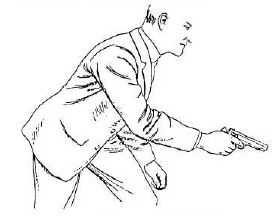 January 1942 was the real turning point for both Sykes and Fairbairn, Section D’s personnel and training schools had been amalgamated into SOE (Special Operations Executive) and they found themselves in charge of close combat training to it’s operatives. However the falling out had been hard, Col. Applegate who trained with both the men separately recalled that neither of them spoke of the other. It was fortunate therefore that only three months after joining SOE (March, 1942) that Fairbairn was sent to STS 103 (Camp X) in Oshawa, Canada to instruct. Later going on to the OSS he didn’t return to the United Kingdom until after the war had ended.
January 1942 was the real turning point for both Sykes and Fairbairn, Section D’s personnel and training schools had been amalgamated into SOE (Special Operations Executive) and they found themselves in charge of close combat training to it’s operatives. However the falling out had been hard, Col. Applegate who trained with both the men separately recalled that neither of them spoke of the other. It was fortunate therefore that only three months after joining SOE (March, 1942) that Fairbairn was sent to STS 103 (Camp X) in Oshawa, Canada to instruct. Later going on to the OSS he didn’t return to the United Kingdom until after the war had ended.
Left to his own devices Sykes prospered, many of the trainee agent’s recalled him as ‘looking like a retired Bishop’ he also acquired the friendly nickname of “Bill” (after the character from the Charles Dickens novel ‘Oliver Twist’).
Sykes became the Instructor in Charge of all SOE’s close combat training, as a part of his duties he formalised what he termed the “Silent Killing” course. This was to become the standard instruction given to all recruit agents in SOE’s (STC) training schools across the world, the first paragraph explained that the course was;
“Designed to teach how to fight and kill without firearms. Since the course includes
the use of the knife, "close combat" is not strictly correct. "Silent Killing" is a more
appropriate description”
The first draft of the course syllabus was in June 1942; interviews with returned agents furnished a continually updated program which Sykes along with his junior instructors taught to trainees. The Silent Killing course was designed, taught and refined by Sykes, the last revision we have available is from December 1943 with a further revised ‘Addendum - Attacking a Sentry’ made available in February 1944.
The latter addendum was produced from Agent reports that German sentry’s had learned of the Sentry Removal instructions and had changed the way they held their rifle when they patrolled. Unfortunately for them the change was noted and acted upon by E.A Sykes.
As well as being the Instructor in Charge of SOE’s close combat training Sykes’s was tasked with drawing up a program of specialist combat training for what were to become known as the ‘Jedburgh Team’s.
In 1943 the Allied commanders realised that their goal of returning to liberate Occupied Europe was coming very much closer. To support them in the coming landings it was decided that Para-Military teams would be dropped into occupied territory to create as much disturbance as possible. This would have the effect of denying re-enforcements and tying up much needed men and arms at a time of crisis.
This was a joint British and United States endeavour, the teams would create havoc behind the lines until (if ever) they were overrun by their own advancing troops, the chances of a safe return were not deemed high.
Sykes wrote what was to be called The Jedburgh manual in May 1943, little knowing that he would become tasked with being in command of all Jedburgh training at their home base at Milton Hall in Northants.
Perhaps the most well known quote of Sykes from this time is from the book “SOE Assignment” by Donald Hamilton Hall.
"He taught unarmed combat and quick shooting reactions such as how to kill four people in a room whilst falling down on the ground near the door lintel to make oneself a difficult target. His methods of unarmed combat and silent killing were such that many were able in the years to come to save themselves entirely owing to his instructions."
It is true to say that Sykes was well regarded in SOE, indeed some have claimed that his nickname of “Bill” was never mentioned to his face. As we shall see this is just another part of the “smokescreen” given by those who never knew him at all well.
During his service with SOE Sykes had risen from his original rank of Captain within Section D to the office of Major. He also headed all close combat instruction of Unarmed Combat, Knife, Stick and Shooting in SOE at home and abroad. In the latter years he was also in sole charge of the complete training of the men of the joint UK/USA project – ‘The Jedburgh’ missions.
It was in SOE that Sykes reached the pinnacle of his career it seemed that all was going so well, but none knew how quickly the time was running out…
Sykes – The End
Towards the end of 1944 Sykes was troubled with ill health, although an extremely fit man for his age the strains of training and travel had began to appear. A brief spell of illness forced him to Hospital and a medical review by SOE’s doctors reclassified him as being ‘Unfit for Service’.
Sykes was forced to retire and left SOE in early 1945, although it was known that he wouldn’t return administrative details meant that his official leaving date was the 6th of April, 1945.
He arrived at a guesthouse in Bexhill on Sea and died on May 12th, 1945 from terminal heart problems. Alone and forgotten by the people and agencies he had served so well he was aged just 62.
His obituary in the Times newspaper (below) was brief – Sykes had been forgotten and was cremated in Kent.

The time spent away from SOE wasn’t wasted on brooding however, he had for some time been writing his own book on self protection methods - what is termed by researchers today as the “Unpublished Manual”.
Although in the manual Sykes himself stated “There is nothing new under the Sun”, the manual contained his definitive and final thoughts on the subject of Self Protection.
Involving all his training ideas and techniques on Unarmed Close Combat and Shooting methods it is feared lost. However this I fear will not prevent unscrupulous persons from attempting to market their own fraudulent versions in the future for their own profit.
These techniques were developed by Sykes experiences not only around the world but especially with his times with SOE, his own beliefs on the reality of self protection.
What is termed WW2 Combatives today is mostly based on the methodology taught by Sykes so long ago.
The Sykes method is still in use today, a legacy from the long ago “Forgotten Hero of Combatives” – in this at least his legacy is honoured.
References:
Some of the books used for this work include:
The Secret History Of SOE – William Mackenzie
SOE: The Special Operations Executive – MRD Foot
The Last Ditch – David Laampe
Close Combat Files Of Col. Rex Applegate - Rex Applegate
The First Commando Knives – Yeaton, Yeaton & Applegate
The Jungle Is Neutral – F Spencer-Chapman
Secret Agent – David Stafford
Operation Sealion – Captain Peter Fleming
The Women who lived for Danger - Marcus Binney
With Britain In Mortal Danger – John Warwicker
Inside SOE – E.H Cookridge
Secret War – Nigel West
Beaulieu: The Finishing School – Cyril Cunningham
Aston House - Des Turner
Behind The Lines – Russell Miller
Secret War Heroes – Marcus Binney
Commando – John Parker
Hand of Steel – Rupert Butler
Magazine Article- Leroy Thompson – “The Shanghai Sniper Rifle” S.W.A.T September, 1998
Various and Numerous Files from Public Records Office, Kew, London
Acknowledgements
Thanks to the following peoples without whom I wouldn’t have been able to complete this work.
(In no particular order)
Paul Gerasimchyk (USA)
Dennis Martin (UK) – visit his website at www.cqbservices.com
James Farthing (UK) – visit his website at www.jimmy-fatwing.com
Mika Soderman (SWE) – visit his website at www.get-tough.net
Stephen Brown (USA)
Mark Gittins (UK)
A big thanks to all of the above for their help and friendship throughout the years, also especially to James Farthing and Stephen Brown (WW2 Combatives Researchers) for allowing me access to their own research files.
In particular I have to thank James Farthing, in this field of research friends are few and far between, they’re also very much valued – thanks for all your help mate!
Another big debt of gratitude is due to David Man for his permission for me to use the Sykes change of name scan and other information from his website. For more details of the relationship of that of his own and the Schwabe family please visit his excellent website. Link to Man family website www.manfamily.org
A final thanks is due to the worldwide Combatives Community, thank you all and remember to Spread the Legacy – Keep it Alive.
The Final Word
Part one of this series on the history of Eric Anthony Sykes deals with just that, the history. When I began writing my thoughts on this well known but little recognised Instructor I never anticipated that it would fill so many pages!
Therefore to conclude I have had to split the material available into two parts to fully give them both justice.
The second part of this series will go further in depth into the physical techniques of Sykes methodology and also my reasoning’s behind him being a member of SIS. It will also explore in more depth the research and development he undertook in weaponry and close combat and his character. Finally it will also show in more detail just how badly the falling out with W.E Fairbairn was, and perhaps the reasons behind this.
As with any of my writing anything I have used in this article can be verified, if it is not included it is because I have no way of determining its truth. My own suppositions are marked as my own and no, I’m not making any money from this!
Phil Matthews
Copyright 2005 - thebristolbloke